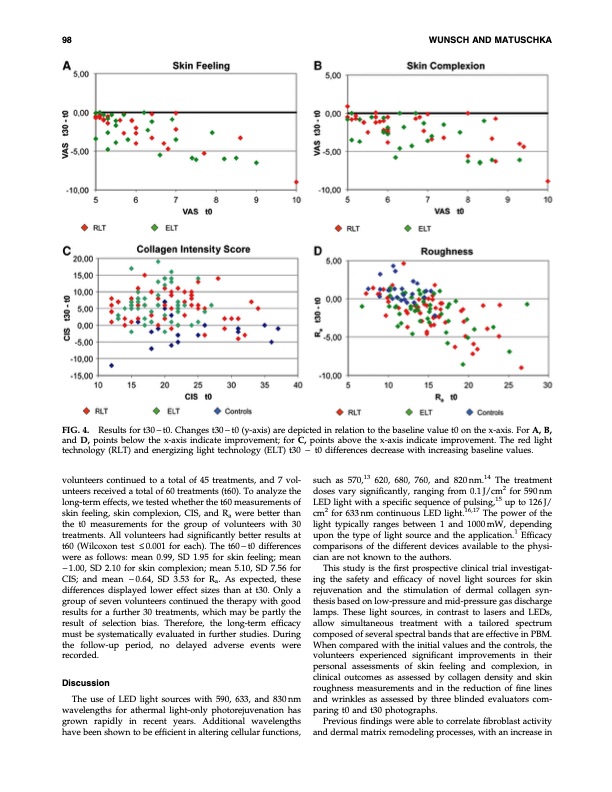
PDF Publication Title:
Text from PDF Page: 006
98 WUNSCH AND MATUSCHKA FIG. 4. Results for t30 - t0. Changes t30 - t0 (y-axis) are depicted in relation to the baseline value t0 on the x-axis. For A, B, and D, points below the x-axis indicate improvement; for C, points above the x-axis indicate improvement. The red light technology (RLT) and energizing light technology (ELT) t30 volunteers continued to a total of 45 treatments, and 7 vol- unteers received a total of 60 treatments (t60). To analyze the long-term effects, we tested whether the t60 measurements of skin feeling, skin complexion, CIS, and Ra were better than the t0 measurements for the group of volunteers with 30 treatments. All volunteers had significantly better results at t60 (Wilcoxon test £ 0.001 for each). The t60 - t0 differences were as follows: mean 0.99, SD 1.95 for skin feeling; mean - 1.00, SD 2.10 for skin complexion; mean 5.10, SD 7.56 for CIS; and mean -0.64, SD 3.53 for Ra. As expected, these differences displayed lower effect sizes than at t30. Only a group of seven volunteers continued the therapy with good results for a further 30 treatments, which may be partly the result of selection bias. Therefore, the long-term efficacy must be systematically evaluated in further studies. During the follow-up period, no delayed adverse events were recorded. Discussion The use of LED light sources with 590, 633, and 830 nm wavelengths for athermal light-only photorejuvenation has grown rapidly in recent years. Additional wavelengths have been shown to be efficient in altering cellular functions, - t0 differences decrease with increasing baseline values. such as 570,13 620, 680, 760, and 820nm.14 The treatment doses vary significantly, ranging from 0.1 J/cm2 for 590 nm LED light with a specific sequence of pulsing,15 up to 126 J/ cm2 for 633 nm continuous LED light.16,17 The power of the light typically ranges between 1 and 1000mW, depending upon the type of light source and the application.1 Efficacy comparisons of the different devices available to the physi- cian are not known to the authors. This study is the first prospective clinical trial investigat- ing the safety and efficacy of novel light sources for skin rejuvenation and the stimulation of dermal collagen syn- thesis based on low-pressure and mid-pressure gas discharge lamps. These light sources, in contrast to lasers and LEDs, allow simultaneous treatment with a tailored spectrum composed of several spectral bands that are effective in PBM. When compared with the initial values and the controls, the volunteers experienced significant improvements in their personal assessments of skin feeling and complexion, in clinical outcomes as assessed by collagen density and skin roughness measurements and in the reduction of fine lines and wrinkles as assessed by three blinded evaluators com- paring t0 and t30 photographs. Previous findings were able to correlate fibroblast activity and dermal matrix remodeling processes, with an increase inPDF Image | Trial to Determine the Efficacy of Red Near-Infrared Light Treatment

PDF Search Title:
Trial to Determine the Efficacy of Red Near-Infrared Light TreatmentOriginal File Name Searched:
red-light-treatment.pdfDIY PDF Search: Google It | Yahoo | Bing
Cruise Ship Reviews | Luxury Resort | Jet | Yacht | and Travel Tech More Info
Cruising Review Topics and Articles More Info
Software based on Filemaker for the travel industry More Info
The Burgenstock Resort: Reviews on CruisingReview website... More Info
Resort Reviews: World Class resorts... More Info
The Riffelalp Resort: Reviews on CruisingReview website... More Info
| CONTACT TEL: 608-238-6001 Email: greg@cruisingreview.com | RSS | AMP |